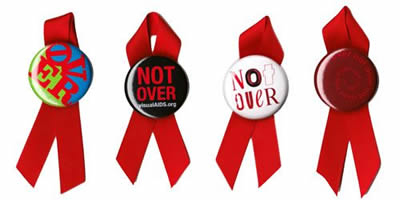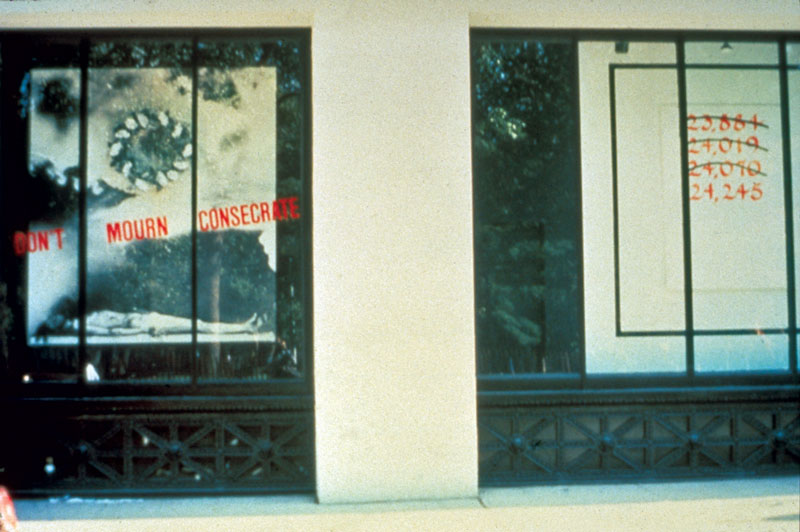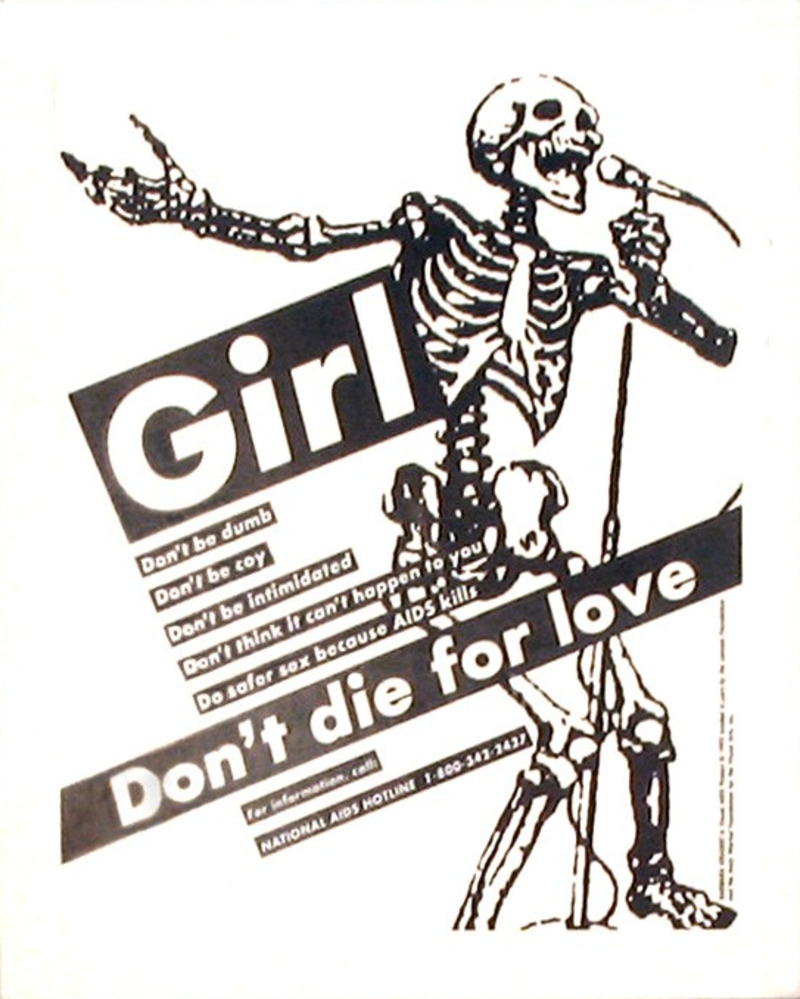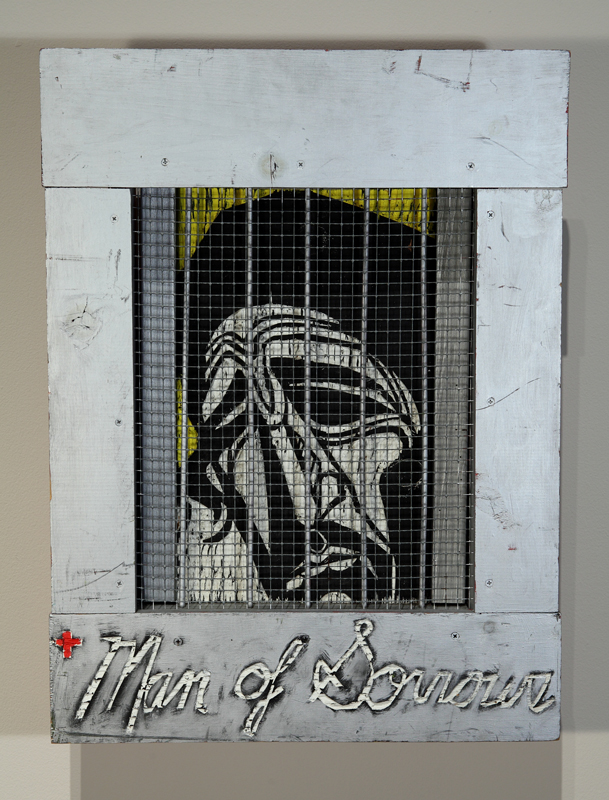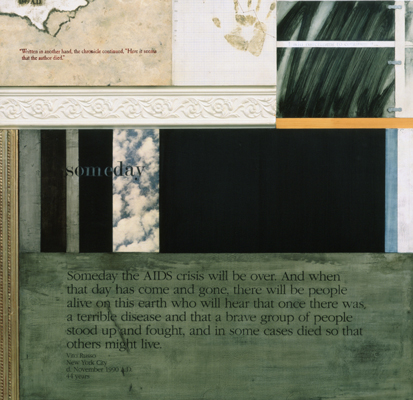Episode 3: Thomas Sokolowski
Release date: Dec. 2011
We report with sadness that Thomas Sokolowski passed away on May 4, 2020. We invite you to read a remembrance by MOCRA Founding Director Terrence Dempsey, S.J.
Curator and art historian Thomas Sokolowski is no stranger to MOCRA audiences, having lectured at the museum in 1994 with a talk called “The Changing Face of AIDS” and again in 2002 with a talk called “The Last Impression: Andy Warhol’s Art as Belief.”
Sokolowski and MOCRA Director Terrence Dempsey, S.J., discuss issues related to art and AIDS. Topics include Sokolowski’s experiences in presenting some of the earliest exhibitions of art about AIDS, and his role in the creation of the red ribbon for AIDS awareness. They also talk about Sokolowski’s role in introducing Dempsey to the late artist Adrian Kellard, and Sokolowski’s significant role in making several MOCRA exhibitions possible.
The Audio Extra features excerpts from Sokolowski’s 1994 talk at MOCRA, “The Changing Face of AIDS.”
Scroll down for a Listening Guide with more information about the topics discussed.
The Conversation
Audio Extra: The Changing Face of AIDS
MOCRA Voices on Stitcher MOCRA Voices on iTunes MOCRA Voices on Spotify
Related Exhibitions
Consecrations: The Spiritual in Art in the Time of AIDS
Andy Warhol: Silver Clouds
Adrian Kellard: The Learned Art of Compassion
Related Episodes
Episode 2: Adrian Kellard
Episode 10: MOCRA Memories – The Early Years
Credits
Producer: David Brinker
Recording Engineer and Editor: Fojammi (Daniel Stefacek)
Host: John Launius
Listening Guide: David Brinker
Background
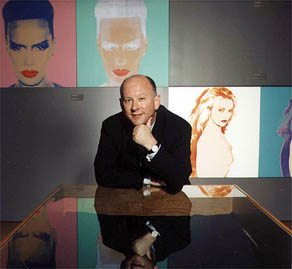 A native of Chicago, Thomas Sokolowski (1950–2020) received his B.A. from the University of Chicago, and earned his master's
degree and did doctoral work in art history at New York University, where he specialized
in late 17th- and early 18th-century Italian art. In the early 1980s, Sokolowski was
curator of European painting and sculpture and later chief curator at the Chrysler
Museum. In 1984 he was named Director of New York University's Grey Art Gallery and
Study Center, where he curated a number of important exhibitions.
A native of Chicago, Thomas Sokolowski (1950–2020) received his B.A. from the University of Chicago, and earned his master's
degree and did doctoral work in art history at New York University, where he specialized
in late 17th- and early 18th-century Italian art. In the early 1980s, Sokolowski was
curator of European painting and sculpture and later chief curator at the Chrysler
Museum. In 1984 he was named Director of New York University's Grey Art Gallery and
Study Center, where he curated a number of important exhibitions.
Sokolowski became Director of The Andy Warhol Museum in Pittsburgh, PA, in 1996, a post he held for 14 years. During his tenure at the Warhol, Sokolowski established a reputation for inventiveness in exhibitions and programming, as well as for civic activism. Sokolowski left The Warhol at the end of 2010. In 2017 he was named Director of the Jane Voorhees Zimmerli Art Museum at Rutgers University. In addition to his work in museums, Sokolowski taught at a number of universities, including New York University, and he was a board member of Visual AIDS.
Listening Guide
Jump to Listening Guide for Audio Extra: The Changing Face of AIDS
| 04:40 |
June 5, 1981, marked the first published descriptions of the disease that would come to be known as acquired immunodeficiency syndrome, or AIDS, a complex of opportunistic infections that take advantage of an immune system weakened by infection with the human immunodeficiency virus, or HIV. Learn more about HIV and AIDS. AVERT provides this timeline of the AIDS epidemic. It may be difficult to appreciate just how devastating the impact of HIV/AIDS was upon those infected in the early years. Lack of scientific knowledge about the disease and its causes led to unfounded rumors and consequent discrimination against, and ostracizing of, both HIV+ patients and people in high risk groups, particularly gay men. The epidemic devastated whole communities with predominantly gay residents, yet also led to grassroots activism to address the needs of the ill, to educate those at risk, to fund scientific research, and to influence government policy and public opinion. The initial U.S. government response was distressingly tepid, but has since become more robust. The magazine article referenced by Sokolowski is likely the article by David Ansen, titled "A Lost Generation," which appeared in the January 17, 1993, issue of Newsweek. This article about a 1990 photo in Life magazine demonstrates how visual imagery played a major role in helping to break down the fear and misinformation that dogged those with HIV/AIDS. |
|||||
| 06:46 | The WPA, or Works Progress Administration, was the largest of the New Deal programs initiated by the administration of Franklin D. Roosevelt. It employed millions of unskilled workers to carry out public works projects, and also funded arts, drama, media, and literacy projects. Many of the artists involved in the WPA’s Federal Art Project are well known today, including Leon Golub, Jacob Lawrence, Philip Guston, Mark Rothko, Arshile Gorky, Lee Krasner, Marsden Hartley, and Diego Rivera. Explore a complete roster of artists on Wikipedia. | |||||
| 08:10 |
Sokolowski notes that the arts community has been disproportionately affected by HIV/AIDS, and has responded to the crisis in the most natural way it could, through the creation and presentation of art. Visual AIDS works for HIV prevention and AIDS awareness through visual art projects, provides assistance to artists living with HIV/AIDS, and preserves and promotes the legacy of HIV+ artists. A similar legacy initiative, the Estate Project for Artists with AIDS, is now housed in the archives of the New York Public Library. As Sokolowski mentions later in this segment, in 1989 Visual AIDS initiated Day With(out) Art, an annual observance each year on World AIDS Day (December 1), for which galleries and museums display (or sometimes remove) works of art, or present other programs to mark the impact of HIV/AIDS on the arts community. MOCRA has participated in many Day With(out) Art observances. Sokolowski mentions other similar arts-related organizations, including Broadway Cares/Equity Fights AIDS. |
|||||
| 08:45 | Kaposi sarcoma (KS) is one of the best known and also most horrifying symptoms of full-blown AIDS. KS is a cancer that causes red or purple patches to appear on the skin, in the lining of the mouth, nose, and throat, or in other organs. Learn more about KS on the American Cancer Society website. | |||||
| 12:15 |
Along with her brother Leo, Gertrude Stein supported and collected the work of Henri Matisse, Georges Braque, Juan Gris, and Pablo Picasso long before their work was generally accepted and acclaimed. |
|||||
| 15:15 |
As seen in this AVERT discussion of the impact of AIDS on the African continent, the disease has affected different countries, regions, and tribal groups in various ways, and the response has been equally varied. HIV/AIDS has spread widely and rapidly, and had a severe impact on life expectancy, family structure, and economic growth and development. The dire poverty in much of the continent has also raised serious ethical and practical issues for drug manufacturers and the agencies that provide treatment. The U.S. President's Emergency Plan for AIDS Relief (PEPFAR) has provided significant financial resources to combat and treat HIV/AIDS in Africa, although these efforts are beset with contention over issues such as abstinence education, abortion and clean needles for IV drug users. |
|||||
| 15:20 |
BBC News provides a look at the history of the red ribbon, including an interview with co-creator Patrick O'Connell, who describes the meetings in May 1991 that led to the ribbon's creation. The inspiration in part came from American folk traditions associated with yellow ribbons, which have been used to signal the welcome home of a released convict by his wife or lover. This symbolism was adapted as a symbol of support first for the U.S. hostages in Tehran in 1979, and for the troops in the first Gulf War in the early 1990s. Actor Jeremy Irons wore a red ribbon while co-hosting 45th Tony Awards ceremony in 1991, as seen in this clip from that broadcast. Awareness ribbons of various colors have become commonplace sight in the years since, such as pink for breast cancer. To commemorate 20th anniversary of the red ribbon, Visual AIDS commissioned four artists to create "Not Over" buttons that can be attached to the red ribbon. |
|||||
| 18:45 | Copyright law concerning visual art can be convoluted, as explained in this guide from Artists Rights Society. | |||||
| 19:55 |
Actress Dame Elizabeth Taylor (1932–2011) was an early and prominent champion for HIV and AIDS programs. She co-founded the American Foundation for AIDS Research (amfAR) in 1985, and established the Elizabeth Taylor AIDS Foundation in 1993. A jewel-studded ribbon like the won described by Sokolowski was sold at auction by Christie's for $21,837 in May 2000. |
|||||
| 22:55 |
Sokolowski touches briefly on a turbulent period in the late 1980s and early 1990s when art, morality and politics collided over a variety of issues, including AIDS and the public funding of art. Artist Andres Serrano, along with photographer Robert Mapplethorpe (1946–1989) and others, was a lightning rod for attacks on the public funding of art through the National Endowment for the Arts (NEA) and the National Endowment for the Humanities (NEH). Their chief adversary was Senator Jesse Helms (1921–2008) of North Carolina. For example, in 1990 the Contemporary Arts Center in Cincinnati was embroiled in controversy over an exhibition of photographs by Mapplethorpe. and the wider cultural context. Scholar Cynthia Koch, writing for the Penn National Commission on Society, Culture and Community, takes a deep dive into challenges to funding for the NEA and NEH. Although the “culture wars” have quieted down to a slow simmer, they still boil over from time to time over works that address AIDS, such as the 2010 controversy involving the National Portrait Gallery and the video work A Fire in My Belly by David Wojnarowicz (1954–1992). Sokolowski mentions President Ronald Reagan (1911–2004), as well as former mayor Ed Koch (1924–2013) and Cardinal John J. O’Connor (1920-2000), both of New York City. Reagan and Koch were both strongly criticized by AIDS activists for their inaction concerning the spreading epidemic. O'Connor had long been an antagonist of the gay and lesbian community in New York—he fought against non-discrimination laws that included sexual orientation, and opposed condom distribution to reduce the spread of AIDS—when he was appointed by Reagan to a presidential commission on AIDS. |
|||||
| 23:50 |
Juan González (1942–1993) was noted for his exquisite magic realist paintings that incorporated art historical references but evoked a state of dreamlike wonder. His work Don't Mourn, Consecrate was first presented in 1987 at New York University's Grey Art Gallery, in street front windows overlooking Washington Square. The work subsequently lent its name to MOCRA's exhibition Consecrations: The Spiritual in Art in the Time of AIDS (1994) and was featured in MOCRA at Fifteen: Good Friday (2009), Good Friday: The Suffering Christ in Contemporary Art (2010), and Gratitude (2019). González quotes a work by Hans Holbein the Younger, now found in the Kunstmuseum Basel. Two of the people Sokolowski mentions as taking part in the "AIDS tally" ritual are Dr. Mathilde Krim (1926–2018), one of the earliest scientists to devote herself to AIDS research, and Larry Kramer (b.1935), a playwright, author, and LGBT rights activist. His 1985 play The Normal Heart won the 2011 Tony Award for best revival. Sokolowski mentions Gran Fury, an activist/artist collective associated with the AIDS activist group ACT UP (AIDS Coalition to Unleash Power). ACT UP made potent use of arresting visuals, such as "Silence=Death," which took the upside-down pink triangle used by the Nazis to stigmatize homosexuals, and inverted it as a sign of resistance and power. Gran Fury become formalized as a collective in 1988, following a 1987 installation created by ACT UP members at the New Museum of Contemporary Art, titled “Let the Record Show. . .” Beneath a neon Silence=Death logo was a gallery of “AIDS criminals” including televangelist Jerry Falwell, Sr. (1933–2007)—who declared “AIDS is God’s judgment of a society that does not live by His rules”—and conservative columnist William F. Buckley, Jr. (1925–2008), who opined that “Everyone detected with AIDS should be tattooed in the upper forearm, to protect common needle users, and on the buttocks to prevent the victimization of other homosexuals.” |
|||||
| 28:40 |
Thomas Sokolowski uses three well-known artworks as examples of “good art.” The famed Pietà by Michelangelo (1475–1564), located in St. Peter's Basilica, depicts the dead Jesus, brought down from the Cross and laid on Mary's lap. Learn more about the work here. The famous fresco by Leonardo da Vinci (1452–1519) of The Last Supper, located in a refectory in a monastery in Milan, Italy, has endured both bombings and restorations over the centuries. More recently, it played a central (if dubious) role in Dan Brown's novel The Da Vinci Code. Read more about the work and its various interpretations here. Guernica, the imposing mural by Pablo Picasso (1881–1973), commemorates the bombing of a Basque town in April 1937 by German forces during the Spanish Civil War. It has become an iconic expression of the horrors of war, especially the suffering imposed on innocent civilians. Learn more about Guernica, now housed at the Museo Reina Sofía in Madrid. The 1931 depiction of George Washington and his forces crossing the Delaware River by Allen Tucker (1866–1939)—found in the collection of the Whitney Museum—will not be easily confused with the much better known 1851 version by Emanuel Leutze (1816–1868), in the collection of the Metropolitan Museum of Art. See the discussion at 6:46 above for more about the Works Progress Administration (WPA). Michelangelo Merisi da Caravaggio (1571–1610) is an artist who continues to command the fascination of contemporary audiences, and the mysteries surrounding his life and death are nearly as compelling as his paintings. Sokolowski is likely referring to the Contarelli Chapel in Rome, which is home to Caravaggio’s highly regarded painting The Calling of St. Matthew. Several touring exhibitions of objects from the tomb of the Egyptian Pharaoh Tutankhamun (c.1342–c.1325 BCE) have traveled the globe since the 1960s. In particular, The Treasures of Tutankhamun, which toured in the 1970s, smashed attendance records at museums worldwide and ushered in the era of the modern museum blockbuster. |
|||||
| 30:15 |
Susan Sontag (1933–2004) is an American novelist, essayist, director, and human rights activist. Illness as Metaphor was published in 1978; a companion volume titled AIDS and its Metaphors appeared in 1988. The two works are now published together—look for it on WorldCat. Tuberculosis is a bacterial disease that primarily effects the lungs, with symptoms including bloody coughs and weight loss. As Sontag explores in her essays, tuberculosis shows up repeatedly in European art and literature. One perennial example, the 1896 opera La bohème, by Giacomo Puccini (1858–1924) was updated a century later in the 1996 Broadway musical Rent by Jonathan Larson (1960–1996), with AIDS assuming the role of tuberculosis. |
|||||
| 32:40 | Learn more about Adrian Kellard in Episode 2: Adrian Kellard. | |||||
| 33:00 |
Thomas Sokolowski organized Precious: An American Cottage Industry of the Eighties in 1985 for New York University’s Grey Art Gallery. Find the exhibition catalogue through WorldCat. Read brief discussions of the exhibition in New York Magazine and the Christian Science Monitor. Thomas Lanigan-Schmidt (b.1948) is known for creating glittering mixed-media constructions that speak directly to issues of sex, class and religion, particularly gay and working-class consciousness as well as theological, philosophical and aesthetic ideas/ideals. An art pioneer in the use of reflective materials, he has influenced subsequent generations of artists—including Adrian Kellard—who have engaged a similar “glitter” aesthetic, exploring themes of glamour, sexual transgression, camp and kitsch, and the relationship between “high” and “low” culture. Lanigan-Schmidt was featured in the retrospective Tender Love Among the Junk at MoMA PS1 in 2012. Abstract Expressionism emerged in New York in the mid-20th century as the first American art movement to achieve worldwide influence. The term applies to a broad range of artists and approaches to art. Explore the 2011 Museum of Modern Art exhibition Abstract Expressionist New York here. |
|||||
| 35:00 | >Pneumocystis pneumonia (PCP) is the most common opportunistic infection in people with HIV. It is caused by a fungus and primarily affects the lungs. PCP does not affect healthy people but can be deadly in people with compromised immune systems. | |||||
| 38:15 |
The corporal works of mercy are acts by which, in the Christian tradition, a person helps another with physical or material needs. They include feeding the hungry, giving drink to the thirsty, sheltering the homeless, clothing the naked, visiting and ransoming those captive or in prison, visiting the sick, and burying the dead. The corporal works of mercy are complemented by spiritual works of mercy. Learn more about the traditional works of mercy. In Judaism, the Hebrew term mitzvah can refer to the divine commandments given in the Torah, or more broadly to moral deeds performed as a religious duty—that is, an act of human kindness. Learn more about mitzvot. |
|||||
Listening Guide for Audio Extra: The Changing Face of AIDS
| 00:00 | This talk was given on November 5, 1994, in conjunction with the MOCRA exhibition Consecrations: The Spiritual in Art in the Time of AIDS. Excerpts are presented here; gaps are indicated by a brief period of silence. | |||||
| 02:30 |
The 1988 Grey Gallery exhibition of photographs by Rosalind Solomon was titled Portraits in the Time of AIDS. Read a summary of the exhibition catalogue, or this [https://www.robertatkins.net/beta/witness/culture/body/difficult.html] essay by Robert Atkins that places the exhibition in its cultural context. [https://www.robertatkins.net/beta/witness/culture/body/artabout.html] Read a commentary by co-curators Robert Atkins and Thomas Sokolowski about the 1992-1993 international traveling exhibition From Media to Metaphor: Art About AIDS. Read The New York Times review of the exhibition. Find the exhibition catalogue through WorldCat. Significant Losses: Artists Who Have Died from AIDS was shown at the University of Maryland from November 2 to December 23, 1994. Don't Leave Me This Way: Art in the Age of AIDS was shown at the National Gallery of Australia in 1994. Read a 1995 review published in The Independent. MOCRA hosted community-wide Day With(out) Art observances in 1994, 2000, and 2006. |
|||||
| 06:55 |
Ichthys (ΙΧΘΥΣ) is Greek for fish, but also has an ancient Christian association as an acronym for Iēsous Christos, Theou Yios, Sōtēr, which translates into English as "Jesus Christ, Son of God, Savior." |
|||||
| 08:26 |
Sokolowski references American artist Jeff Koons (b. 1955) and in particular the series Made in Heaven, featuring explicit portrayals of Koons in intimate encounters with his wife, Italian porn star Cicciolina (Ilona Staller). Watch an interview with Koons on the PBS series Art21. Sokolowski also mentions Michelangelo’s famous frescoes for the Sistine Chapel. Take a virtual tour of the Sistine Chapel here. |
|||||
| 09:10 |
Sokolowski is making an oblique reference to the NEA and NEH funding controversies. See the Listening Guide to the Conversation above at 22:55. |
|||||
| 10:50 |
Robert Indiana's ubiquitous rendering of the word “LOVE” has appeared in many context and media since its creation in 1964. The art collective Gran Fury, associated with AIDS Coalition to Unleash Power (ACT-UP), reworked Indiana's image with the word "RIOT." See the Listening Guide to the Conversation above at 23:50, for more about Gran Fury and ACT-UP. |
|||||
| 12:00 | The Biblical account of the events of Pentecost is found in the second chapter of the Acts of the Apostles. | |||||
| 12:55 |
See the Listening Guide to the Conversation above at 23:50, for a discussion of Don't Mourn, Consecrate, by Juan González. An exhibition titled The Interrupted Life was shown at the New Museum Sept. 13–Dec. 29, 1991. Sokolowski mentions a 1991 work by artist Donald Moffet (b.1955) titled Mercy. Sokolowski mentions one of the lasting testaments to the widespread response to AIDS, the AIDS Memorial Quilt, sections of which still travel to communities around the country each year. In early 2020, The Quilt and associated archival material were transferred to the stewardship of the National AIDS Memorial in Washington, D.C. Maya Lin (b.1959) won a competition in 1981 to design the Vietnam Veterans Memorial located near the National Mall in Washington, D.C. The Memorial receives around 3 million visitors a year. Watch an interview with Maya Lin on the PBS series Art21. |
|||||
| 16:45 | Works by Rod Rhodes were included in the MOCRA exhibition Consecrations: The Spiritual in Art in the Time of AIDS. | |||||
| 18:12 |
The Farm Security Administration (FSA) was a Roosevelt administration effort during the Great Depression to address American rural poverty. Its innovative photography program (1935–1944) engaged photographers and writers to document and report on the plight of poor farmers. Images such as those by Dorothea Lange rank among America’s iconic images. Many of the FSA photographs can be browsed courtesy of the Library of Congress. |
|||||
| 18:45 | Photographer Jane Rosett and her partner Jean Carlomusto curated an interactive memorial project titled AIDS: A Living Archive. | |||||
| 19:10 |
In 1993 New York University's Grey Art Gallery presented a solo exhibition by Bill Jacobson (b.1955) titled Interim Figures. See the works on the artist's website. |
|||||
| 20:20 | See the Listening Guide to the Conversation above at 8:10 for a discussion of Day With(out) Art. | |||||
| 22:37 |
Hillary Leone (b.1962) and Jennifer Macdonald (b.1958) had a 10-year collaborative relationship creating art that addressed social and political issues such as the AIDS pandemic, censorship, and the marginalization of those viewed as “other.” Their work included objects and installations, including works with braille executed on sandpaper. Visit the duo’s website. Barbara Kruger (b.1945) is well known for works emblazoned with bold slogans that carry multiple, sometimes contradictory, meanings. Watch an interview with Kruger on the PBS series Art21. The work referenced by Sokolowski was shown in a 2005 exhibition at the Mildred Lane Kemper Art Museum titled Inside Out Loud: Visualizing Women's Health in Contemporary Art. Adrian Kellard was the subject of MOCRA’s 2011 exhibition Adrian Kellard: The Learned Art of Compassion. Learn more about Kellard in MOCRA Voices, Episode 2: Adrian Kellard. |
|||||
| 23:52 | See the Listening Guide to the Conversation above at 15:20 and 19:55 for discussions of the Red Ribbon. | |||||
| 26:30 |
Bubonic plague is a bacterial disease that has killed millions of people across the century during various outbreaks. The most notable was in 1347—an event known as the Black Death—which took the lives of one-third of the population of Europe. A number of writers and artists have drawn parallels between the Black Death and the AIDS pandemic. Among them is Robert Farber, whose Western Blot series juxtaposes the words of medieval victims of the plague and contemporary people living with HIV/AIDS. Robert Farber: A Retrospective, 1985–1995 was shown at MOCRA in 2000. |
|||||
